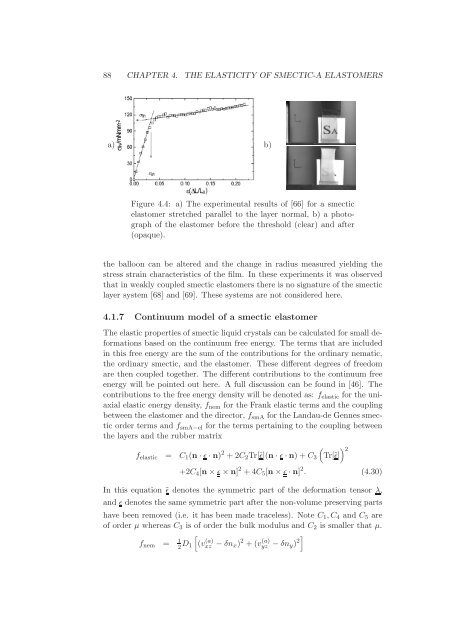Statistical models of elasticity in main chain and smectic liquid ...
Statistical models of elasticity in main chain and smectic liquid ...
Statistical models of elasticity in main chain and smectic liquid ...
You also want an ePaper? Increase the reach of your titles
YUMPU automatically turns print PDFs into web optimized ePapers that Google loves.
88 CHAPTER 4. THE ELASTICITY OF SMECTIC-A ELASTOMERSa) b)Figure 4.4: a) The experimental results <strong>of</strong> [66] for a <strong>smectic</strong>elastomer stretched parallel to the layer normal, b) a photograph<strong>of</strong> the elastomer before the threshold (clear) <strong>and</strong> after(opaque).the balloon can be altered <strong>and</strong> the change <strong>in</strong> radius measured yield<strong>in</strong>g thestress stra<strong>in</strong> characteristics <strong>of</strong> the film. In these experiments it was observedthat <strong>in</strong> weakly coupled <strong>smectic</strong> elastomers there is no signature <strong>of</strong> the <strong>smectic</strong>layer system [68] <strong>and</strong> [69]. These systems are not considered here.4.1.7 Cont<strong>in</strong>uum model <strong>of</strong> a <strong>smectic</strong> elastomerThe elastic properties <strong>of</strong> <strong>smectic</strong> <strong>liquid</strong> crystals can be calculated for small deformationsbased on the cont<strong>in</strong>uum free energy. The terms that are <strong>in</strong>cluded<strong>in</strong> this free energy are the sum <strong>of</strong> the contributions for the ord<strong>in</strong>ary nematic,the ord<strong>in</strong>ary <strong>smectic</strong>, <strong>and</strong> the elastomer. These different degrees <strong>of</strong> freedomare then coupled together. The different contributions to the cont<strong>in</strong>uum freeenergy will be po<strong>in</strong>ted out here. A full discussion can be found <strong>in</strong> [46]. Thecontributions to the free energy density will be denoted as: f elastic for the uniaxialelastic energy density, f nem for the Frank elastic terms <strong>and</strong> the coupl<strong>in</strong>gbetween the elastomer <strong>and</strong> the director, f smA for the L<strong>and</strong>au-de Gennes <strong>smectic</strong>order terms <strong>and</strong> f smA−el for the terms perta<strong>in</strong><strong>in</strong>g to the coupl<strong>in</strong>g betweenthe layers <strong>and</strong> the rubber matrixf elastic = C 1 (n·ǫ·n) 2 +2C 2 Tr[˜ǫ](n·ǫ·n)+C 3(Tr[˜ǫ]+2C 4 [n×ǫ×n] 2 +4C 5 [n×ǫ·n] 2 . (4.30)In this equation ˜ǫ denotes the symmetric part <strong>of</strong> the deformation tensor λ,<strong>and</strong> ǫ denotes the same symmetric part after the non-volume preserv<strong>in</strong>g partshave been removed (i.e. it has been made traceless). Note C 1 ,C 4 <strong>and</strong> C 5 are<strong>of</strong> order µ whereas C 3 is <strong>of</strong> order the bulk modulus <strong>and</strong> C 2 is smaller that µ.[f nem = 1 2 D 1 (v xz (a) −δn x) 2 +(v yz (a) −δn y) 2]) 2
















